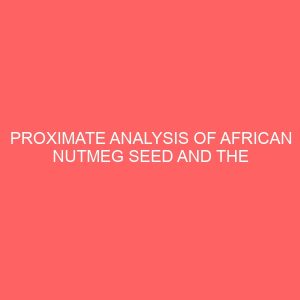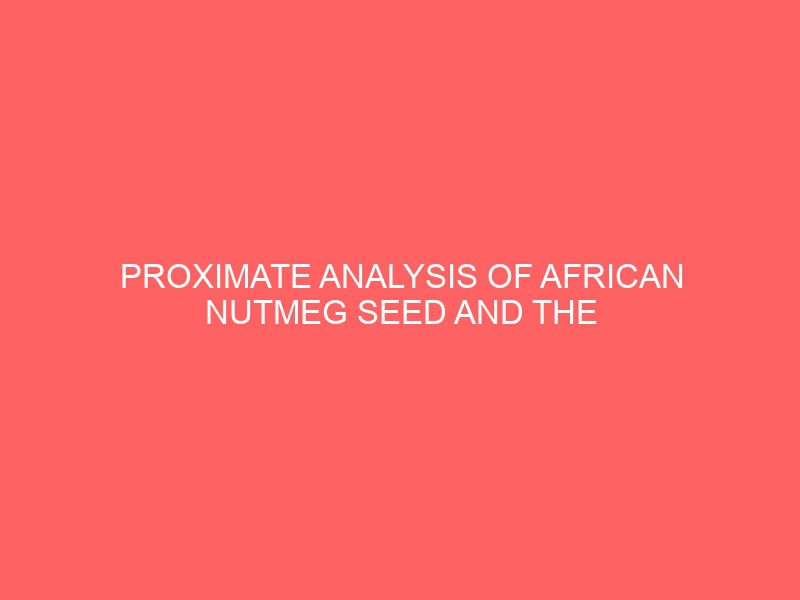Description
CHAPTER ONE
1.0 INTRODUCTION
Plants were the main source of drugs for the Worlds population before the synthetic medicines evolved. But estimates are that up to 80 of the Worlds populations still rely on traditional medicine.
Africa is rich in plant biodiversity and by using traditional knowledge supported by scientific research, more phytomedicinal products become available. An increased demand for natural alternatives to synthetics support research into seeing the chemical constituents of plants that are significant to human and animals. Mpuntu African Phytomedicinals.
1.1 BRIEF DESCRIPTION OF NUTMEG AND AFRICAN NUTMEG
The nutmegs Myristica are a genus of evergreen trees indigenous to tropical Southeast Asia and Australia. They are important for two species derived from the fruit, nutmeg and mace. Nutmeg is the actual seed of the tree, roughly eggshaped and about 2030mm long and 1518mm wide while mace is the dried lacy reddish covering or arillus of the seed www.wikipedia.com
Several other commercial products are also produced from the trees, including essential oils, extracted oleoresins and nutmeg butter.
The most important specie commercially, is the common or fragrant Nutmeg Myristica fragrans, native to the Banda islands of Indonesia. It is also grown in the Caribbean, especially in Grenada. Other species include Papuan nutmeg M.argentea from New Guinea and Bombay Nutmeg M.malabarica from India. Both are used as adulterants of M. fragran product. The free Encyclopedia
Pycnanthus angolensis also known as Pycnanthus kombo is a tree of about 100ft high and 8ft in girth. Occasionally more evergreen. Bole straight, cylindrical without buttresses. It has a grey bark, longitudinally fissured, flaking in patches in old trees, slash reddish and exudes a sticky honeycolored juice turning red. The seed has the same features as the common nutmeg Traditional medicine and pharmacopoeia
1.2 SCIENTIFIC CLASSIFICATION OF NUTMEG
KINGDOM: Plantae
DIVISION: Magnoliophyta
CLASS: magnoliopsida
ORDER: Magnoliales
FAMILY: Myristicaceae
GENUS: Myristica
In terms of specie, there are about 100 species of Myristicaceae family, some of which include:
Myristica argentea
Myristica fragrans
Myristica malabarica
The African nutmeg belongs to the family of Myristica fragrans and the fruit resembles those of pycnanthus Traditional medicine and pharmacopoeia
1.3 USES OF NUTMEG AND AFRICAN NUTMEG
1.3.1 Nutmeg and mace part have similar taste and qualities nutmeg having a slightly sweeter and mace part a more delicate flavour. Mace is often preferred in light coloured dishes for the bright orange, saffronlike colour it imparts.
In Indian cuisine, nutmeg is used almost exclusively in sweets.
In European cuisine, nutmeg and mace are used especially in potato dishes and in processed meat products; they are also used in soups, sauces and baked goods.
It is used in the treatment of tongue inflammation
It is used in treating diarrhoea
It is used in the treatment of tooth ache and tooth decay
Nutmeg is a traditional ingredient in mulled cider and mulled wine Wikipedia.com
1.3.2 African nutmeg is also known as kombo butter with a natural geographical distribution stretching across western Africa. The oblong shaped fruits contain oilrich seeds vegetable fat encased in a hard shell. A variety of uses for most tree parts, ranging from incorporation of the plant in furniture, condiments, soaps and cattle feed to medicinal uses is known. Kombo butter, a reddish brown butter, is widely used for ethno medical purposes and is likely to become the much needed vegetable substitute for animalfat based cetyl myristoleate CMO used in arthritis management. It has potential of lowering glucose concentrations in type2 diabetes, anticancer and cholesterol lowering. It posses significant antioxidant and antiinflammatory activities Mpuntu African Phytomedicinals Medically, the plant is used for the treatment of tongue inflammation and menorrhagia Traditional medicine and pharmacopoeia.
1.4 SCOPE OF STUDY
The research work span through the evaluation, extraction of oil, physical/chemical analysis as well as proximate analysis of the oil extracted from Pycnanthus angolensis African nutmeg
1.5 LIMITATIONS
The research work is limited to an extent, in that it does not entail the following:
i Analysis of the seed
ii Evaluation of the fruit
iii Analysis on the nutritional content of the seed as well as the oil
1.6 AIMS AND OBJECTIVES
The aim of this research work is to extract the oil of African nutmeg and analyse the physical and chemical characteristics of the oil.
The study examined:
a The methods of oil extraction
b The determination of moisture and ash content of the seed
c The mineral content determination of the oil
d Carbon content determination
e Other physical/chemical analysis of the oil
1.7 DEFINITION OF TERMS
The routine analysis of products/substance is termed the proximate analysis which is done to know the component of the sample Oyeleke 1984
Proximate analysis which include moisture, ash, fat etc. has considerably high values in terms of general information about samples.
1.7.1 MOISTURE CONTENT: This is an index of stability and quality of the sample under test. It gives an idea of the amount of water in a given sample. This can influence the food quality, processing, packaging and also shelf life of samples. The moisture content must be known in expressing results of analytical determination on a uniform basis and meeting compositional standard Ibitoye 2002.
1.7.2 ASH CONTENT: The ash content of a biological materials is an analytical term used for the inorganic residue that remains after the organic matter has been burnt off. The ash may not usually be the same as inorganic matter present in the original sample, because there may be losses due to the volatilisation or chemical reaction between the contents Adekunle 2000.
The importance of the ash content is that it gives an idea of the amount of mineral element present in the sample, while the inorganic matter gives an estimate of protein, lipids fat and these are useful in accessing the quality of or grading certain edible materials Ibitoye 1999.
1.7.3 CRUDE FAT: Fats are usually defined as those components that are soluble in organic solvents like ether, hexane, but are insoluble in water Rosenberg 2000. Solvents extraction technique is one of the most commonly used methods of isolating lipids fats from foods Seeds, grain and of determining the total content of foods or other products. The procedure is to continuously extract the fat content with organic solvent like either or hexane. This method is based on the principle that nonpolar components of the samples are easily extracted by non polar solvent Ibitoye 1999.
1.7.4 ACID VALUE: This is the number of milligrams of the potassium hydroxide necessary to neutralize the free acid in 1g of sample. The acid value is often a good measure of the breakdown of the triacylglycerols into free fatty acids which has an adverse effect on the quality of many fats Grundy 1999.
1.7.5 SAPONIFICATION VALUE: This is the amount of alkali necessary to saponify a definite quantity of the sample. It is expressed as the number of milligrams of potassium hydroxide KOH required to saponify 1g of the sample. The smaller the saponification values, the larger the average molecular weights of the triacylglycerols present Grundy 1999.
Triacylglycerol 3KOH Glycerol 3fatty acids of potassium
CH20COC17H35 CH2OH
CH0COC17H35 3KOH CHOH 3C17H35COOK
CH20COC17H35 CH2OH
Stearin Glycerol Potassium Stearate
1.7.6 PEROXIDE VALUE: Peroxide ROOH is the primary reaction product formed in the initial stage of oxidation and therefore, gives an indication of the progress of lipid oxidation Grundy 1992
1.7.7 VISCOSITY: For many liquids, specific gravity is used which is ratio of the mass of a given volume of the sample to the mass of an equal volume of water. The specific gravity decreases with increased temperature and decreases slightly as viscosity decreases for similar compositions Atkins 1999
1.7.8 MINERAL CONTENT: This is a measure of specific inorganic component present in a sample such as Ca, Na, K and Cl. The quality of some samples depends on the concentration and type of minerals they contain including their taste, appearance, texture and stability. High mineral content are sometimes used to retard the growth of certain microorganisms Atkins 1999.








Reviews
There are no reviews yet.